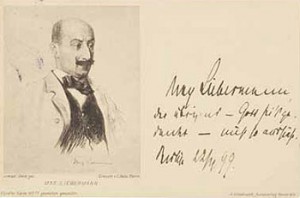Archive Seeks Memorabilia to Preserve the German-Jewish Tradition
A side street off 5th Avenue. Close to Union Square. The Center for Jewish History. Most passers-by are unaware of the treasure lying behind the heavy brick walls: The library and archives of the Leo Baeck Institute. They contain the most significant collection of source material relating to the history and culture of German-speaking Jewry. Established in 1955, the founders wanted to gather as much original documentation as possible in order to write a history of the decimated Jewish population of Carol Kahn Strauss, director of the Leo Baeck Institute, greets architect Daniel Libeskind in the Jewish Museum in Berlin Leo Baeck Institute in New York central Europe. They wanted to give names to the nameless, give a voice to those who had been silenced. The institute’s namesake was the last rabbi of the Jewish community in Berlin under the Nazis.
From the writings of Martin Luther to Moses Mendelssohn, Kafka and Einstein, to unheralded generations of merchants, scientists, artists, authors, rabbis and housewives – more than 500 years of triumphs and tragedies are recorded in the books and papers cataloged at the Institute.
The LBI is the only organization dedicated exclusively to the documentation of Germanspeaking Jewry, which is inextricably linked to Europe’s cultural, intellectual and political history over the past 500 years. These invaluable resources are used by students, scholars and statesmen around the world, either as original documents, microfilm, or by digital access.
New material continues to arrive daily, especially as the survivor population ages. The importance of these documents cannot be emphasized enough: if they do not become part of the permanent record now, preserved for future generations to interpret and evaluate from new perspectives, they will be lost to history.
Indeed, while the history of the Holocaust is extremely well documented, the years prior to that, specifically from 1870-1933, have received much less attention. Yet these are precisely the years when Jews in Germany had greater opportunity and more advantages than Jews anywhere else in Europe. There were more Jewish doctors, lawyers, business owners, journalists, craftsmen and entrepreneurs in Germany than in any other European nation. The LBI collection of personal letters, memoirs, diaries and photographs attest to the life that came to such an unexpected end between 1933 and 1945.
In the continuum of history, the Holocaust was perhaps the worst event but not the end of the story of German Jews. Today the Jewish population in Germany is the fastest growing Jewish population in Europe, seeking to reclaim a legacy that was severed, but remains accessible largely through the efforts of Leo Baeck Institute.
The urgency of the task is clear: It is to continue to collect, preserve and make available the remarkable heritage of our lives. Jews in the former German Democratic Republic have so far been largely excluded from efforts to study this history, but they too are a vital part of the picture, especially the Jewish “remigrants” who were forced to flee under the Nazis but returned to live under the Communists. There is a special urgency for the Institute to gather whatever documentation is still available.
For the LBI to effectively carry out its mission, it needs your help. Search your own archives for documents held by either you, your friends or relatives that will tell our story when we can no longer tell it ourselves. The Institute exists to preserve this heritage.
The story of German-speaking Jewry reflects the global dimensions of our history, its ongoing connection to other people in other places. In this context Judaism is not only a religion, but a culture that remains uniquely relevant – politically, socially and intellectually. It is a dynamic heritage that must not be forgotten.
The LBI archive in New York, and at the Jewish Museum Berlin, welcomes students, genealogists and historians to engage in research and the study of families, communities, organizations, movements and events. Whatever happened to German-Jewry is cataloged and accessible to users around the world who seek context and understanding of this remarkable legacy.

